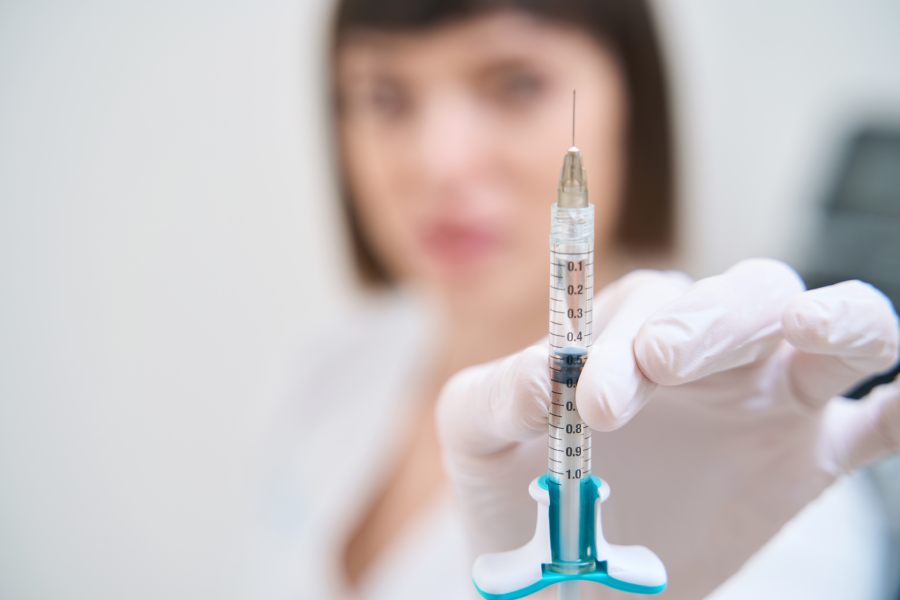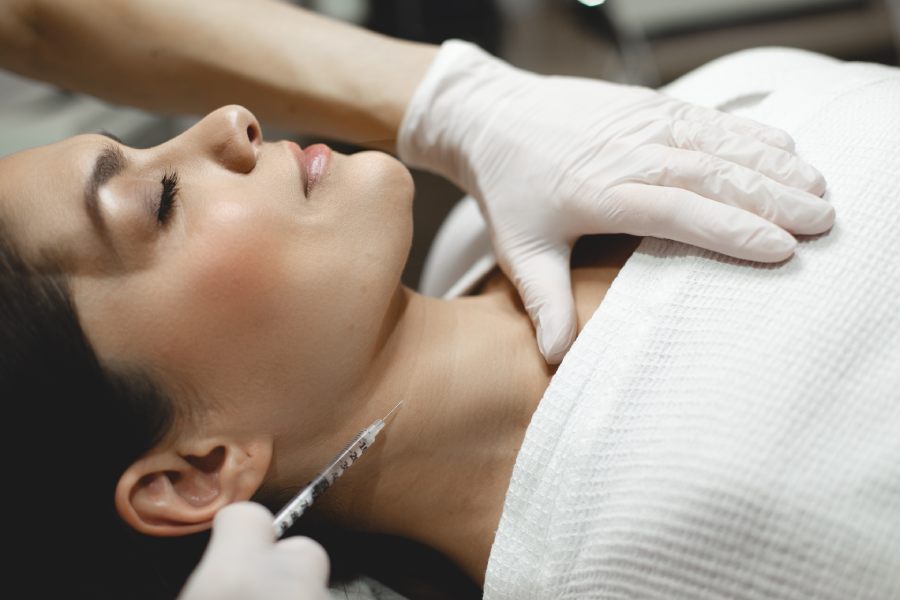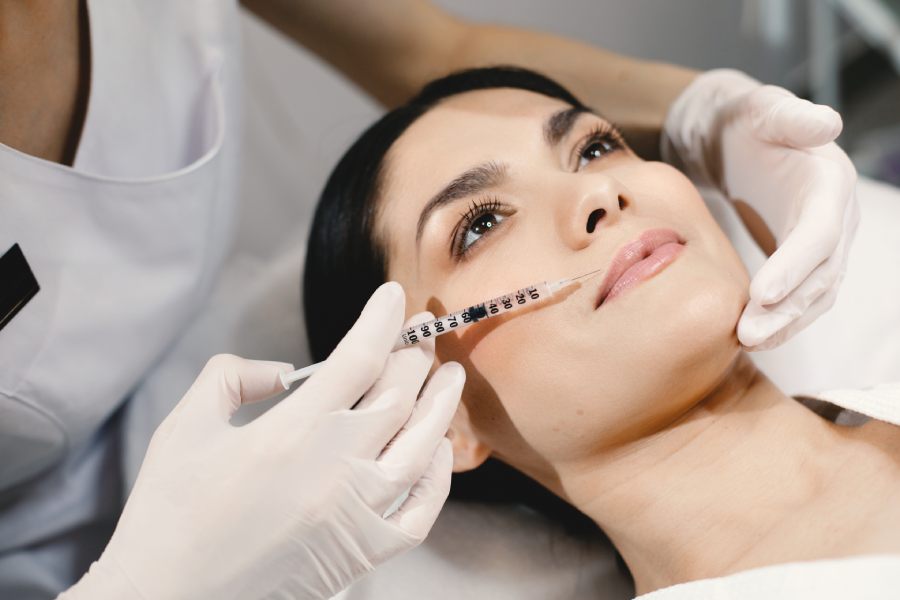The need to address wrinkles and fine lines and achieve a more youthful appearance is normal. The effects of aging are inevitable, and with time, the skin is prone to sagging and becomes less smooth. Even though many are familiar with the standard facelift surgery, what is a liquid facelift?
A noninvasive cosmetic technique known as a liquid facelift is employed to diminish wrinkles and enhance facial fullness without surgery. The procedure utilizes injectables, usually dermal fillers, alongside Botox.
This article covers all the ins and outs of liquid facelifts. Take a look at the benefits and risks of this procedure as well as its price. How this non-surgical procedure works and what types of fillers are commonly used?
[ez-toc]

Source: shutterstock.com / Photo Contributor: YAKOBCHUK VIACHESLAV
What is Liquid Facelift and Who Should Consider it
A liquid facelift refers to a minimally invasive cosmetic technique aimed at diminishing wrinkles and enhancing facial fullness without surgery. This procedure utilizes injectables or dermal fillers, along with Botox to achieve its effects. The liquid facelift may restore facial fullness, achieve a plump skin effect, and may reduce sagging. The fillers are aimed at reducing sagging and softening wrinkles.
As part of the aging process, our skin loses its elasticity as a result of connective tissues, such as collagen breaking down. Facial aging studies also recognize fat loss as a catalyst for aging.. Overall, a combination of factors contributes to the altered appearance of the skin.
Additionally, unlike typical facelifts, the liquid facelift is a non-surgical procedure. Many professionals claim that it gives individuals a more genuine and subtle look.
Liquid facelifts are usually recommended to individuals in their 30s and 40s. During this period, the skin’s elasticity is still prominent, and the desired results are easier to pursue. Dermatologists usually recommend liquid facelifts to people with a small amount of wrinkles and sagging on their faces.
So, what is a liquid facelift benefit that you will enjoy after the procedure? Replenishing and countering effects are the most sought-after effects of this procedure. Overall, it is said that the younger the person, the better the outcome.
Where is liquid facelift applied
More advanced wrinkles and aging signs require more complicated procedures. The most common target areas of the liquid facelift are:
- The cheeks
- Jowls
- The temples
- Near the eyebrows
- Around the eyes
- Marionette lines (the fold between the nose and the mouth)
The target areas may depend on your situation. Thus the facelift procedure varies from one individual to another.

Source: shutterstock.com / Photo Contributor: RomarioIen
How does a liquid facelift work
The procedure for the liquid facelift is far less complicated than the traditional facelift. As part of your first appointment with Dr. Gerstle, you will undergo a regular exam and receive an evaluation of your skin’s condition. The doctor will discuss the procedure and provide a solution based on your unique situation. After the scope of the treatments has been agreed upon, an appointment for the procedure may be scheduled.
Here is what you may expect if you decide that a liquid facelift is the right fit:
- The doctor will inject a dermal filler into your skin to achieve a plumper look.
- Before doing so, he will inject a local anesthetic.
- According to the American Academy of Dermatologists, the filler procedure takes no longer than 30 minutes.
- The filler injections are performed with a thin needle.
- Before the needle injections, the doctor gently massages the target area to help the filler settle smoothly.
We should also mention that most liquid facelifts may be completed in just one sitting. Some, however, might require additional appointments.

Source: shutterstock.com / Photo Contributor: Anton Mukhin
Liquid facelift- potential risks
Gaining a deeper understanding of what is a liquid facelift means understanding the risks involved. This is why prior to the procedure, patients are asked to sign a consent form. They need to confirm that they understand the potential harms and risks involved.
The liquid facelift, also known as a dermal filler injection, is a relatively safe procedure. The chances of severe negative effects are very low. Still, potential risks are involved, which is why transparency is essential. According to the American Society of Plastic Surgeons, some of the possible complications based on the different types of fillers involved include:
- Bruising
- Infection
- Asymmetry
- Skin rash
- Swelling
- Redness
- Wound and scarring
- Acne-like eruptions
- Bleeding from the injection site
Though good results are expected, significant complications are possible. All of the potential risks will be discussed during the initial exam with Dr. Gerstle. However, it is still important to address complex questions.
Different types of liquid facelift dermal fillers
Botox is arguably the most popular and most frequently mentioned injectable. As you may already know, it is often used in combination with dermal fillers. However, we should bring plenty of other fillers to your attention.
It is important to note that as each facelift procedure or a combination of more procedures, each filler has its own purpose. Here are some of the most common and most used liquid facelift fillers:
Sculptra
Sculptra is well-known for its volumizing properties. The main ingredient found in this filler is poly-L-lactic acid. This filler is unlike others as it stimulates collagen production, and its effects are witnessed gradually. However, Sculptra does not produce immediate results. You may need to go to three to five treatments before witnessing long standing results. The effects usually last no more than two years.
Autologous
Autologous fat is used when we wish to avoid harmful allergic reactions. It is harvested from the individual’s body, lowering the chance of rejection. This pallet-rich-plasma (PRP) technique is also known as the vampire facelift. The fat cells injected during this facial rejuvenation may vary.
Some claim that dermatologists may sometimes overfill the area to achieve the needed effect. Still, there is no proof to these claims. It is best to say that this is a two-to-three-treatment procedure spread over the course of 2 months.
Restylane
Restylane is usually paired with Botox to achieve long-lasting results and enhance its effect. It may be preferred for moderate facial lines and wrinkles. Its main ingredient is hyaluronic acid, a natural substance in our bodies. The filter may be famous for its moisture-retaining abilities and its ability to bind to collagen and elastin.
Juvederm
Juvederm is another filler that contains hyaluronic acid in its structure. Just like in its other forms, hyaluronic acid may be used to tend to moderate facial lines and wrinkles. Juvederm is used by those who might wish to add volume and contour to the face.
Perlane
Perlane may be effective at filling deeper folds and contributing to facial fullness. Besides being regularly used for facial enhancement, it is a standard ingredient for lip enhancement.
Artefill
Artefill is the only non-resorbable dermal filler approved by the FDA. It is made of polymethylmethacrylate (PMMA) microspheres, a material commonly found in surgical implants. It came to its fame due to the possibility of providing permanent wrinkle correction. However, as it is not a natural substance, the risk of an allergic reaction is increased.
How Long Does a Liquid Facelift Last
Traditional facelift recovery time differs from the liquid facelift. The results of the liquid facelift may be visible within the first 24 hours. Still, this largely varies based on the type of filler you choose for the procedure and the location of the injections. With some, more than one treatment may be needed.
There is no official research concerning the longevity of liquid facelifts. How long your facelift lasts will mainly depend on factors such as the type of filler you choose, the treated areas, and more. Unofficially, we may say that the liquid facelift may last anywhere between 6 to 24 months.

Source: shutterstock.com / Photo Contributor: Anton Mukhin
Liquid Facelift: Price
The cost of a liquid facelift may vary greatly based on location; however, it is also tailored to the individual and their unique needs. Determining the exact price of the facelift remains impossible due to other factors involved, such as the physician’s experience, the quality of the filler, and more.
Individuals may expect the cost of the average liquid facelift to be around $3,000. However, it is worth noting that additional touch-ups and maintenance will incur much more in the long run. Cost may run as high as $8,000 or low as $2,000, depending on the type of work being done.
Facelift Surgery vs. Liquid Facelift
Deciding which one of these makes a better option can be difficult. When trying to reach a decision, it is best to compare the purpose and benefits of traditional facelift with liquid facelift. Considering your budget is also recommended.
Here are a few key factors that you should have in mind about each of these cosmetic procedures.
Facelift surgery
- Being a surgical procedure, it requires general anesthesia, which involves greater risk.
- It may require a minimum of one to two weeks of downtime and a more extensive recovery period.
- A one-time process that may provide much longer-lasting results.
You Might be Interested: how to speed up facelift recovery
Liquid facelift
- A non-surgical facelift may be simpler to perform.
- Involves minimum downtime, and patients may continue their daily activities right away.
- Short-time results, and needs to be repeated again.
What remains most important when choosing between the two is considering what is a liquid facelift used for and what is the purpose of facelift surgery. Certain things may only be improved with a liquid facelift, while other things may only be corrected by surgery.
